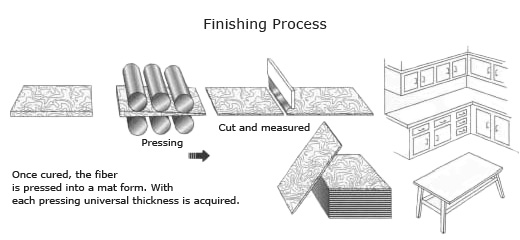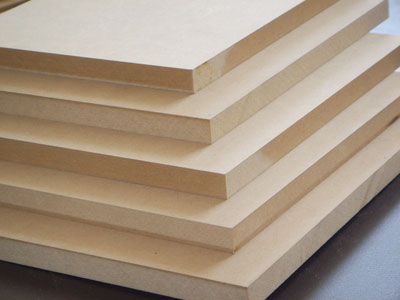
Background
Composite forest products, or engineered wood, refer to materials made of wood that are glued together. The more popular composites materials include plywood, blockboard, fiberboard,
particleboard, and laminated veneer lumber. Most of these products are based on what were previously waste wood residues or little used or non-commercial species. Very little raw material
is lost in composites manufacture.
Medium density fiberboard (MDF) is a generic term for a panel primarily composed of lignocellulosic fibers combined with a synthetic resin or other suitable bonding system and bonded together
under heat and pressure. Additives may be introduced during manufacturing to improve certain properties. Because fiberboard can be cut into a wide range of sizes and shapes, applications are
many, including industrial packaging, displays, exhibits, toys and games, furniture and cabinets, wall paneling, molding, and door parts.
The surface of MDF is flat, smooth, uniform, dense, and free of knots and making finishing operations easier and consistent. The homogenous edge of MDF allows intricate and precise machining
and finishing techniques. Trim waste is also significantly reduced when using MDF compared to other substrates. Improved stability and strength are important assets of MDF, with
stability contributing to holding precise tolerances in accurately cut parts. It is an excellent substitute for solid wood in many interior applications.
Raw Materials
Wood chips, shavings, and sawdust typically make up the raw materials for fiberboard. However, with recycling and environmental issues becoming the norm, waste paper, corn silk, bagasse
(fibers from sugarcane), cardboard, telephone directories, and old newspapers are being used.

Synthetic resins are used to bond the fibers together and other additives may be used to improve certain properties.
The Manufacturing Process
Advanced technology and processing have improved the quality of fiberboard. These include innovations in wood preparation, resin recipes, press technology, and panel sanding techniques.
Advanced press technology has shortened overall pressing cycles, while anti-static technology has also contributed to increased belt life during the sanding process.

Wood preparation
Producing quality fiberboard begins with the selection and refinement of the raw materials, most of which are recycled from shavings and chips reclaimed from sawmills and plywood plants.
The raw material is first removed of any metal impurities using a magnet. Next, the material is separated into large chunks and small flakes. Flakes are separated into sawdust and wood
chip piles.
The material is sent through a magnetic detector again, with the rejected material being separated for reuse as fuel. Good material is collected and sent into a presteaming bin. In the
bin, steam is injected to heat and soften the material. The fibers are fed first into a side screw feeder and then into a plug screw feeder, which compresses the fibers and removes water.
The compressed material is then fed into a refiner, which tears the material into usable fibers. Sometimes the fiber may undergo a second refining step in order to improve fiber purity.
Larger motors on the refiners are sometimes used to sift out foreign objects from the process.
Curing and pressing
Resin is added before the refining step to control the formaldehyde tolerances in the mixture, and after refining, a catalyst is added. The fibers are then blown into a flash tube dryer,
which is heated by either oil or gas. The ratio of solid resin to fiber is carefully controlled by weighing each ingredient. Next, the fiber is pushed through scalping rolls to produce a
mat of uniform thickness. This mat goes through several pressing steps to produce a more usable size and then is trimmed to the desired width before the final pressing step. A continuous
press equipped with a large drum compresses the mat at a uniform rate by monitoring the mat height. Presses are equipped with electronic controls to provide accurate density and strength.
The resulting board is cut to the appropriate length using saws before cooling.
Panel sanding
To achieve a smooth finish, the panels are sanded using belts coated with abrasives. Silicon carbide has typically been used, but with the requirement for finer surfaces, other ceramic
abrasives are utilized, including zirconia alumina and aluminum oxide. Eighthead sanding equipment and double-sided grading improves surface smoothness consistency. Anti-static technology is
used to remove the static electricity that contributes to rapid loading and excessive sanding dust, thereby increasing belt life.

Quality Control
Most MDF plants use computerized process control to monitor each manufacturing step and to maintain product quality. In combination with continuous weight belts, basis weight gauges, density
profile monitors, and thickness gauges, product consistency is maintained as well as formaldehyde emission limits. As environmental regulations and market conditions continue to change, these
standards are revised.
